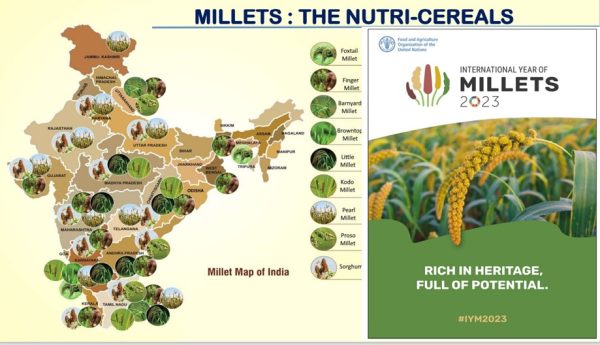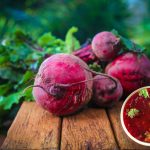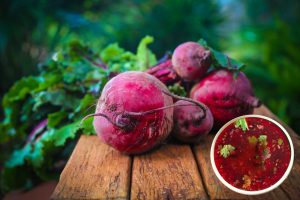
Millet Mindfulness- International Year Of Millets 2023 #IYM2023 #YearofMillets
United Nations declared Year 2023 as the year of Millets. Millets are grown and used as daily foods in Asia, Africa, some parts of Europe, rest of the world not that familiar with millets. To introduce the nutrition value, food security and adoptability to various weather conditions this year declared as year of millets. This is the #YearofMillets.
How does millet benefit agriculture & food security?
- These are climate-resilient crop
- Tolerate dry weather conditions and reduces soil degradation
- Can be vital in improving food & nutrition security
Millets are known as Nutri cereals. Compared to wheat, corn and rice millets exhibit much more nutrition value and considered to be best for health of both humans and animals. In fact, Millets are best choice for mother and young ones. Millets are the first plants that are domesticated on earth and are traditional staple foods of millions in Africa and Asia. Millets are adoptable to adverse climate conditions and show resistant to many diseases and pests.
The diverse groups of Millets encompass pearl millet, finger millet, barnyard, little millet, kodo millet, proso, black & white falno, Job’s tears, teff, Raishan sorghum , little millet -more than 16 varieties. India which is a major production of millets following millets are produced and exported –Sorghum (Jowar), Pearl Millet (Bajra), Finger Millet (Ragi) Minor Millets (Kangani), Proso Millet (Cheena), Kodo Millet (Kodo), Barnyard Millet (Sawa/Sanwa/Jhangora), Little Millet (Kutki), Two Pseudo Millets (BuckWheat/Kuttu), Ameranthus (Chaulai) and Brown Top Millet.
Mindfulness Millets- India’s proposal to mark the International Year of Millets (IYM):
The Food and Agriculture Organization (FAO) of the United Nations, organized an opening ceremony for the International Year of Millets – 2023 (IYM2023) in Rome, Italy. An Indian delegation led by Shobha Karandlaje, Minister of State, Agriculture & Farmers and other senior officials were present at the opening ceremony. During the event, India’s ceremonial message by the Prime Minister Shri Narendra Modi was conveyed by Karandlaje. PM Modi complimented the United Nations for declaring the Year 2023 as the International Year of Millets. PM, through his message, thanked the global community for supporting India’s proposal to mark the International Year of Millets (IYM). It was mentioned that Millets are good for the consumer, cultivator, and climate.
United Nation has put forth importance of millets in six points (From UN)
1. The sustainable cultivation of millets can support climate-resilient agriculture SDG 13 (Climate Action) and SDG 15 (Life on Land)
• Millets are often referred to as climate-resilient crops because they can grow on arid lands with minimal inputs and maintenance, are tolerant or resistant to diseases and pests and are more resilient to climate shocks than other cereals.
• Including and/or expanding the production of millets in national agricultural systems can support the transformation to more efficient, inclusive, resilient and sustainable agrifood systems for better production, better nutrition, a better environment and a better life.
2. The sustainable production of millets can fight hunger and contribute to food security and nutrition SDG 2 (End Hunger)
• In arid areas, millets are very often the only crops that can be harvested in the dry season and are a crucial part of the household food basket. Millets can help to overcome food scarcity in difficult periods, therefore contributing to the food security and nutrition of vulnerable populations.
• Millets can grow in very poor and fertile soils in dryland conditions and do not heavily deplete soil nutrients. By providing land cover in arid areas, they reduce further soil degradation and help support biodiversity and sustainable land restoration.
3. Millets can be an important part of a healthy diet SDG 3 (Good Health and Well-Being)
• Millets are good sources of minerals, dietary fiber, antioxidants and protein. With a low glycemic index, they are a good option for people with high-blood sugar. Millets are also gluten-free and an excellent and cost-effective source of iron for iron-deficient diets.
• As whole grains, each variety of millets provide different amounts and types of fiber. Dietary fiber has a role in regulating bowel function, blood sugar and lipids, and satiation.
4. Greater consumption of millets can offer opportunities to smallholder farmers to improve their livelihoods SDG 8 (Decent Work and Economic Growth)
• The production of millets and the demand for them has declined as other cereals such as wheat, maize or rice became a dietary preference. By promoting millets and regaining market opportunities, additional sources of revenue can be created for smallholders and in the food sector, boosting economic growth.
• Millets were among the first plants to be domesticated and for centuries, they have been an important food for hundreds of millions of people in sub-Saharan Africa and Asia. They are deeply rooted in Indigenous Peoples’ culture and traditions and therefore a strategic crop to guarantee food security in areas where they are culturally relevant.
5. Proper handling of millets is key to maintaining their high quality and nutritional benefits SDG 2 (End Hunger) and SDG 3 (Good Health and Well-Being)
• Timely harvesting ensures good grain quality followed by threshing to remove grains from the stalks. Controlled mechanized processes for the dehusking of millets, at any scale, are more efficient than manual dehusking, as they reduce losses from spillage and provide clean intact grains that are ready for market. Smallholders and supply chain holders benefit accordingly from better incomes and reduced drudgery.
• Innovative agro-processing, especially in the production of nutritious foods, could target both traditional and non-traditional markets such as youth, urban consumers, tourists etc. This value addition could lead to market expansion, and increased food and nutrition security and incomes for smallholder farmers.
6. Greater trade in millets can improve the diversity of the global food system SDG 8 (Decent Work and Economic Growth) and SDG 12 (Sustainable Consumption and Production)
• Millets, including sorghum, account for less than 3% of the global grains trade. With the need to improve the resilience of global trade and its ability to respond to sudden changes in the food grain market, millets are a valuable option to increase output diversity and mitigate risks related to production shocks.
• Market structure and transparency, in relation to volumes and prices of millets, are key elements to ensure stability and sustainability. It is important to ensure that millet traders benefit from the same tools as other grain traders, such as digitalization, which could boost the added value of millet along the grains value chain and consequently provide more revenue opportunities for producers.
- India’s major millet exporting countries : U.A.E, Nepal, Saudi Arabia, Libya, Oman, Egypt, Tunisia, Yemen, U.K and U.S.A. The varieties -Bajra, Ragi, Canary, Jawar, and Buckwheat.
- The major millet importing countries in the world : Indonesia, Belgium, Japan, Germany, Mexico, Italy, the U.S.A, United Kingdom, Brazil and The Netherlands.
- It is estimated that the millets market is set to grow from its current market value of more than USD 9 billion to over USD 12 billion by 2025.
References:
- https://www.fao.org/millets-2023
- https://trello.com/
- https://pib.gov.in/PressReleasePage.aspx?PRID=1881256
- https://currentaffairs.adda247.com/
Author: Sumana Rao | Posted on: January 9, 2023
« Dhara Mustard Hybrid DMH-11 Genetically Modified Mustard Crop Field Trial Approved In India Now You Can Eat Kuldhas After Drinking Tea »






















Write a comment